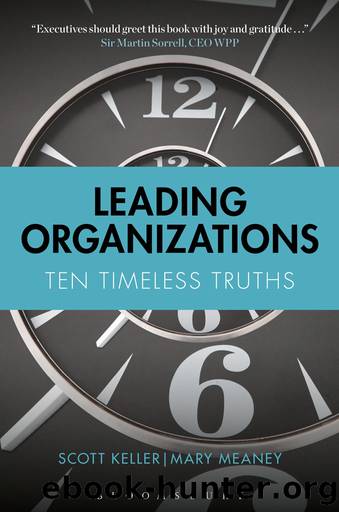Leading Organizations by Scott Keller

Author:Scott Keller
Language: eng
Format: epub
Publisher: Bloomsbury Publishing
Published: 2017-07-15T00:00:00+00:00
Levers for redesigning an organization
What are the big ideas?
AGILITY REQUIRES STABILITY
AUSTRALIAN-BORN media mogul Rupert Murdoch is often credited with saying, âThe world is changing very fast. Big will not beat small anymore. It will be the fast beating the slow.â This makes for a great sound bite (as youâd expect from a media man!), but fast doesnât really help if youâre headed to the wrong destination. Weâd argue that the real advantage lies in being agile, not just fast. Whatâs the difference? Agility involves not just speed, but balance, coordination, strength, stamina, and reflexes. You can get speed by doing the same thing, only faster. Agility is smarter and more gracefulâand knows when being first isnât about being fast (the adage âthe second mouse gets the cheeseâ sums up the sentiment).
Columbia Business School professor Rita Gunther McGrathâs research sheds light on an agile organizationâs look and feel. She found that large companies that disproportionately grow their income vs. others have two main characteristics: âOn the one hand, [growth companies] are built for innovation, [they are] good at experimentation [and] can move on a dime. On the other hand, theyâre extremely stable, [the] strategy and organization structure stay consistent [and the] culture is strong and unchanging.â23 Our research confirms this: companies that are both fast and stable are over three times more likely to be high-performing than those that are fast, but lack stable operating disciplines.
The power of this idea shouldnât be underestimated. Most leaders see the speed and flexibility that drives innovation at the opposite end of the spectrum from standardization and centralization which drive efficiency and control risk. This is a false trade-off. Perhaps an apt analogy is that of society at large, where individual freedom is at one end of the spectrum and government control is at the other. Yet they need each other: without submission to and enforcement of the law, a free society would become anarchy.
In practical terms: to be agile, leaders should determine which parts of their organization design are stable and unchanging and, at the same time, create looser, more dynamic elements that can be adapted quickly to new challenges and opportunities. Using a smartphone analogy, you need to choose your hardware and operating system first (stability), and then let go of control so that useful apps can be developed and improved (agility). So, for example, you might choose a primary axis of organization (stability) while facilitating the formation of temporary performance cells around solving specific needs (speed). Or standardize work in a few signature processes (stability) and coordinate work through iterative cycles in other areas (speed). Or you could emphasize a set of shared cultural values (stability) while radically empowering the front line to make decisions in keeping with these values (speed).
Companies with an agile organization design have another relatively unique feature: They break the cycle of going through large-scale organization redesigns every couple of years. Why? They achieve a state of continuous reorganization around a stable core.
Download
This site does not store any files on its server. We only index and link to content provided by other sites. Please contact the content providers to delete copyright contents if any and email us, we'll remove relevant links or contents immediately.
Bad Blood by John Carreyrou(5780)
Principles: Life and Work by Ray Dalio(5334)
Rich Dad Poor Dad by Robert T. Kiyosaki(5162)
Management Strategies for the Cloud Revolution: How Cloud Computing Is Transforming Business and Why You Can't Afford to Be Left Behind by Charles Babcock(4135)
The Confidence Code by Katty Kay(3576)
Thinking in Bets by Annie Duke(3540)
Playing to Win_ How Strategy Really Works by A.G. Lafley & Roger L. Martin(3019)
American Kingpin by Nick Bilton(2983)
Delivering Happiness by Tony Hsieh(2926)
Project Animal Farm: An Accidental Journey into the Secret World of Farming and the Truth About Our Food by Sonia Faruqi(2667)
Brotopia by Emily Chang(2594)
I Live in the Future & Here's How It Works by Nick Bilton(2531)
Mastering Bitcoin: Programming the Open Blockchain by Andreas M. Antonopoulos(2517)
The Power of Habit by Charles Duhigg(2497)
The Content Trap by Bharat Anand(2496)
The Marketing Plan Handbook: Develop Big-Picture Marketing Plans for Pennies on the Dollar by Robert W. Bly(2421)
The Tyranny of Metrics by Jerry Z. Muller(2407)
Building a StoryBrand by Donald Miller(2368)
Applied Empathy by Michael Ventura(2334)
